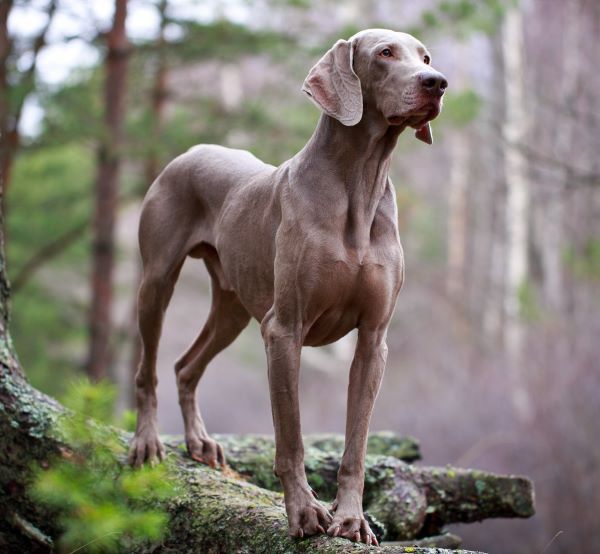Weimaraner


| Recommended for | Active households, families with older children, and experienced dog owners |
| Breed Classification | Sporting Group (Gundog) |
| Other names | Weim, Silver Ghost, Grey Ghost |
| Lifespan | 10 to 12 years |
| Size | Medium to large |
| Temperament | Friendly, energetic, loyal, protective |
| Intelligence | High; quick to learn, responsive to training |
| Tendency to bark | Moderate to High; vocal and alert when needed, often used as a watchdog |
| Maintenance Level | Medium |
| Health Risk | This breed has an around average probability of having health issues in its lifetime, hence it is one of the more affordable breeds to insure. |
Insuring a Weimaraner?
Get our award-winning Nose-to-Tail Cover with up to $30k annual benefit limit, up to 90% of eligible vet bills back, and no sub-limits.
Get a quick quote
Is this breed right for you?
Try our breed selector quiz to find out your best matching breed!
Insuring a Weimaraner?
Get our award-winning Nose-to-Tail Cover with up to $30k annual benefit limit, up to 90% of eligible vet bills back, and no sub-limits.
Get a quick quote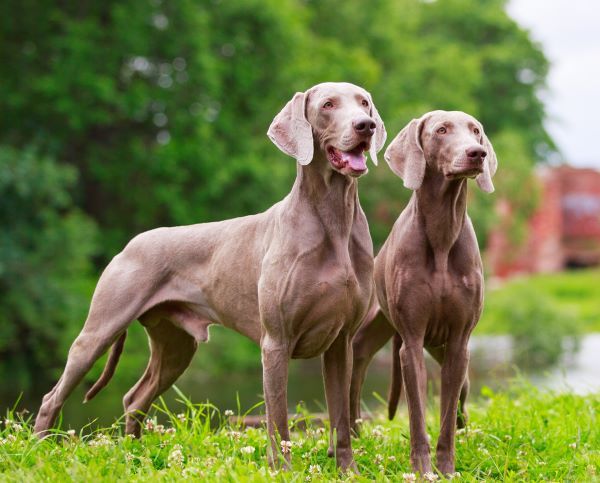
Breed history of Weimaraners
The Weimaraner originated in Germany where it was developed in the early 1800’s for hunting large game such as wild boars, deer and bears. The breed was highly sought after by the gentry and it quickly became a popular hunting companion for German nobility. Because the breed was so highly valued, it was generally kept in the family home and not with the other hunting dogs in the kennels.
The Weimaraner was developed largely through the efforts of Grand Duke Karl August of Weimar, through selective breeding of hunting breeds, including the German Pointing breeds. One of the Weimaraner’s early ancestors is the Red Schweisshunden dog, whose genetic recessive red and tan colour was responsible for producing the unique silver-taupe colour of the Weimaraner.
It was not easy to purchase a Weimaraner; strict rules governed their breeding and only members of the German Weimaraner Club were permitted to own and hunt with one. When the popularity of large game hunting declined, Weimaraners became a versatile companion, excelling in both tracking and retrieving, and were put to work flushing out rabbits, foxes and other small game.
The first Weimaraners came to Australia in 1955, followed by further imports from around the world, as Australian breeders continued to improve the breed’s structure and temperament. Today, the Australian Weimaraner is recognised as a highly competitive gundog and, as a result, there is a growing interest from international breeders to import Australian bloodlines.
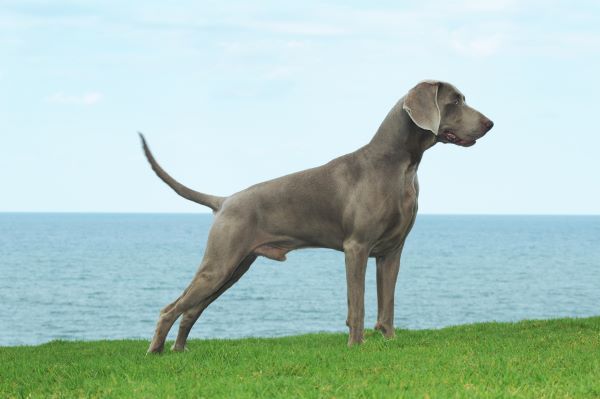
Physical description of Weimaraners
The Weimaraner is a medium to large-sized breed with a sleek, athletic, and well-muscled build and a strong, balanced frame designed for speed and endurance. It has a distinctive head with a long muzzle, large, expressive eyes, and a slightly raised brow, which imbue an intelligent and alert expression. Its ears are long, floppy, and carried close to the head.
The breed is known for its striking silver-grey coat, which is short, smooth, and close-fitting, giving it a polished and elegant appearance. Its long, graceful neck, well-proportioned body, and deep chest contribute to its majestic and athletic look.
The Weimaraner’s tail was traditionally docked, but this practice is now illegal in many countries. Left natural, the long tail is carried high and whips about with excitement during play.
| Weight range | 25 to 40 kg |
| Height range | 60 to 70 cm |
| Colours | Silver-grey, sometimes with a light fawn or "blue" tint |
| Coat length | Short, smooth, and close-fitting |

Weimaraner personality and temperament
The Weimaraner is an energetic, intelligent, sociable and affectionate breed that forms strong bonds with its family. Weimaraners are often described as “velcro dogs” because they love being close to their family members. They are playful and eager to please, making them great companions for active households that can offer plenty of exercise and mental stimulation. Always ready for an adventure, they are equally happy to cuddle up with their loved ones at the end of the day.
Weimaraners tend to be shy and wary with strangers but will warm up to them soon after being introduced. Unlike many other hunting dogs, this is not an independent breed. They require a good deal of human attention and will never show a desire to spend time apart from their owner. If left without contact for an extended period of time, the breed is susceptible to severe bouts of separation anxiety, often resulting in damage to property or injury to the animal if it tries to escape.
Weimaraners are high-energy, high maintenance dogs that require a lot of close human contact and hours of exercise, playtime and affection to keep them fit and happy. With their high energy levels, they thrive in homes with space to run and play, but can also adapt to smaller living conditions if their exercise needs are met. Regular walks, active play, and mental stimulation are essential to keep them happy and well-behaved.
Weimaraners’ high intelligence and energy levels require mental challenges to keep them engaged. They are quick learners that respond well to training, making them suitable for dog sports such as obedience, agility, and scent work. Their intelligence, loyalty, and emotional sensitivity also make them well-suited for therapy and assistance roles, providing both companionship and emotional support.

Weimaraners with kids and other pets
The Weimaraner is an excellent companion for families, particularly those with children. Their energetic personality and eagerness to please make them great playmates, and their loyalty ensures they are protective of younger family members. However, they are an energetic and excitable dog; this combined with their large size can result in smaller kids being knocked over and hurt. As such, Weimaraners do best in homes with older children who can handle their boisterous nature and interact with them responsibly.
When it comes to other pets, Weimaraners are generally friendly but can be a bit dominant due to their strong hunting instincts. They tend to get along well with other dogs, especially if raised together or properly socialised from a young age. However, their prey drive might cause issues with smaller pets, such as cats or rabbits, as they may have the instinct to chase. Early and consistent socialisation is essential to ensure Weimaraners interact peacefully with other pets.
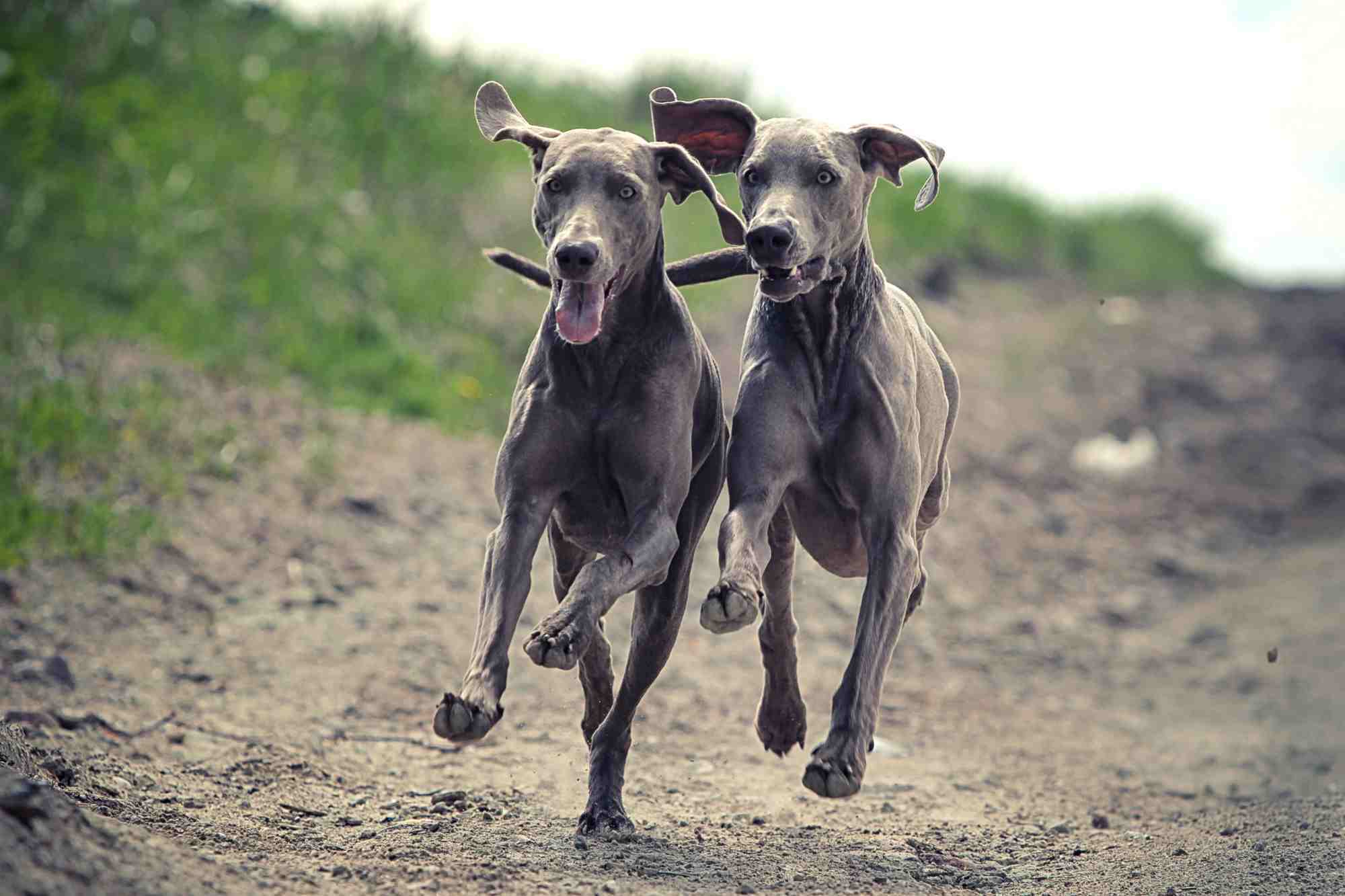
Weimaraner training and exercise
The Weimaraner is a highly energetic breed that requires both physical exercise and mental stimulation to thrive. They are active dogs with a strong desire to run, play, and explore. Daily walks, jogs, and interactive activities like fetch or swimming are ideal to keep them healthy and happy. Weimaraners are particularly fond of outdoor activities, so engaging in regular games or agility training will help fulfil their exercise needs. Without sufficient physical activity and mental stimulation, they can become restless, anxious, or develop undesirable behaviours.
Weimaraners form deep bonds with their family members and love being involved in daily activities. They thrive in homes where they can participate in outdoor adventures or simply enjoy quality time with their owners. Being social animals, they dislike being left alone for long periods – ensuring regular attention, affection, and interaction is crucial to their emotional well-being.
Training a Weimaraner requires patience, consistency, and positive reinforcement. They are intelligent, sensitive and eager to please, making them highly trainable, and they do best when training is fun, engaging and rewarding. Early socialisation is key to ensuring they grow up to be well-behaved, confident and adaptable dogs.
| Energy level | High |
| Exercise requirements | High |
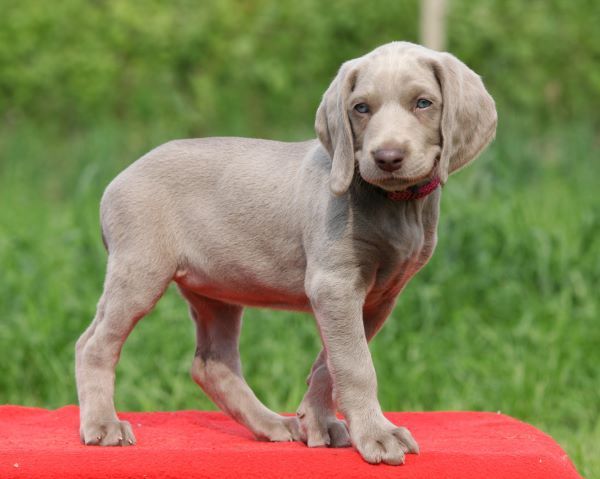
Weimaraner feeding and nutrition
As an active and high-energy breed, Weimaraners require a balanced diet that is rich in high-quality proteins, healthy fats, and essential nutrients. This helps support their lean, muscular build and provides the necessary fuel for their energetic lifestyle.
As Weimaraners age, their dietary requirements will evolve. Puppies require nutrient-rich food to support their rapid growth and development, while adults benefit from a balanced diet that maintains their energy levels without promoting weight gain. Senior Weimaraners may need food with lower calories and added joint-supporting supplements to manage the effects of aging and maintain mobility. Adjusting their diet as they age will help keep them healthy, active, and at a healthy weight throughout their lives.
Controlling calorie intake is important to prevent obesity, which can cause strain on their joints and overall health. Regular mealtimes, portion control, and monitoring their weight are key to maintaining a healthy weight. Routine veterinary check-ups are vital for identifying and addressing any nutritional concerns early.
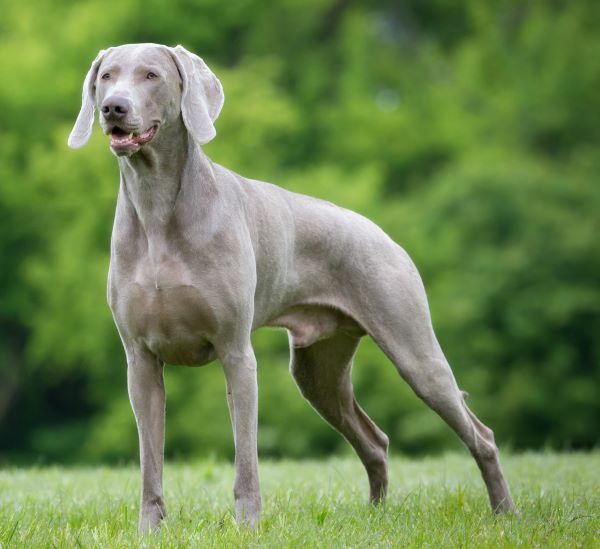
Weimaraner care and grooming
The Weimaraner has a short, sleek coat that is relatively easy to care for. Brushing a few times a week helps remove loose hair and keep the coat looking shiny and smooth. Weimaraners are moderate shedders, with the majority of shedding occurring during seasonal changes, and consistent grooming will help control shedding and keeps the dog’s coat in top condition.
Weimaraners only require bathing when they get particularly dirty. Nail trimming is important to prevent overgrowth, which can cause discomfort or mobility issues. Their ears should be checked and cleaned regularly to avoid infections, as moisture or debris may get trapped in the ears. Dental care is also crucial, and routine teeth brushing or professional cleanings will help prevent tartar buildup and maintain good oral health.
Health issues for Weimaraners
- Hip dysplasia can occur in Weimaraners, leading to joint pain, stiffness, and arthritis. Early detection and maintaining a healthy weight can help manage the condition and improve quality of life.
- Hypothyroidism is a thyroid condition where the thyroid gland is underactive, causing symptoms like weight gain, lethargy, and a dull coat. It is managed with medication and dietary adjustments.
- Progressive Retinal Atrophy (PRA) is a genetic eye disorder that causes gradual vision loss and eventual blindness. Regular eye exams help detect the condition early, and genetic testing can reduce its incidence in future generations.
- Bloat (Gastric Dilatation-Volvulus) is a life-threatening condition where the stomach fills with gas and twists, cutting off blood flow. It can lead to vomiting, restlessness, and a swollen abdomen. Immediate veterinary attention is necessary.
- Cushing’s Disease occurs when the adrenal glands produce excessive cortisol, leading to symptoms like excessive thirst, urination, and weight gain. Medication and regular vet visits help manage Cushing’s disease.
- Cancer can occur in Weimaraners, particularly bone and skin cancer. Regular veterinary check-ups and early detection can help manage treatment options.
- Environmental and food allergies can affect Weimaraners. Symptoms may include itching, redness, and excessive licking or scratching. Managing allergies with the help of a vet is crucial for their comfort and well-being.
- Ear infections often occur in Weimaraners due to their long, floppy ears. Regular ear cleaning is essential to prevent build-up of dirt and moisture, which can cause infections.
- Dental issues in Weimaraners include tartar build-up and gum disease. Regular brushing and professional cleanings are essential to maintain oral health.
Not all conditions are covered by Pet Insurance. For details of Bow Wow Meow Pet Insurance cover, refer to the Product Disclosure Statement.
Thinking about insuring a Weimaraner
Thinking about insuring a Weimaraner
Learn moreThinking about insuring a Weimaraner
Learn moreFree engraved pet ID tag on sign up3
Customer Satisfaction
21 day cooling off
Easy to use Pet Portal

GapOnly® in vet claims
MORE INFORMATION
The Weimaraner Club of NSW: http://www.weiclubnsw.com/
The Weimaraner Club of South Australia: http://www.weiclubsa.com/
The Weimaraner Club of Victoria: http://www.weimaranervic.com/

